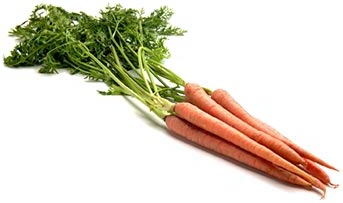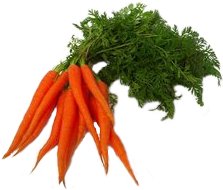

Carrots

Daucus carota. Umbelliferae. Biennials grown as annuals for their edible, orange-red storage roots. Wild types, which have thin roots almost white or pale yellow in colour, occur in SW Asia and the Mediterranean, with a few in Africa, Australia and N America. The cultivated carrot, subspecies sativa, seems to have originated in Afghanistan: its long-conical roots were purple, violet or almost black. From this centre the edible carrot spread both east – to China in the 13th or 14th century and eventually Japan – and west, to Asia Minor and Spain, reaching England in the 15th century. A yellow mutation arose at some stage and later a white one, which was mainly used for animal fodder. The familiar orange carrot was selected from the yellow in the Netherlands around 1600AD, and different shapes arose later. Edible carrots were taken to North America by settlers. The orange colour of cultivated varieties is due to the presence of beta-carotene, a precursor of Vitamin A reputed to enhance night vision. Carrots are now widely grown in both temperate and subtropical regions of the world. Carrots are a cool-season crop growing best at mean temperatures of 16-18ºC. At 28ºC and above, top growth is reduced and roots become very strongly flavoured. Below 16ºC roots become long and tapered and are pale in colour. The leaves are moderately sensitive to frost but the unharvested roots can remain in the soil unprotected without damage. In temperate regions the main crop is lifted during summer and autumn but a combination of advancing the early crop and storing the later harvest makes it practical to maintain a regular supply of roots throughout the year. Small whole carrots or sliced large ones can also be deep-frozen. The carrot crop is extremely sensitive to soil conditions and well-shaped roots will only be obtained if they are able to grow without restriction. The best soil is a light friable one that permits easy root penetration and development and also leads to minimal damage during harvesting. Stony soils will also cause roots to become misshapen during development. Peaty soils are also suitable providing they are deep and well drained. Very sandy soils may need the addition of organic matter to improve their water retention but on no account should fresh manure be used as this will cause roots to develop fangs. Soil pH should be between 6.5-7.5. Where possible a long rotation should be used between crops: at least five years is recommended to reduce any build-up of carrot root eelworm and violet root rot. Sow seed in shallow drills approximately 2cm deep. Plant spacing has a marked effect on the total yield and final root size. Large carrots will grow at a wide spacing corresponding to approximately 50 plants per square metre (40 per square yard). This can be achieved with an inter-row spacing of about 37cm, thinning plants to 5cm apart within the row. Increasing plant population reduces individual root size without affecting the final yield thus permitting root size to be regulated to meet requirements. A population of about 165 plants per square metre/40 per square yard will give small carrots suitable for serving whole. This population can be obtained from rows 30cm apart and plants spaced 2cm apart. Of course, root size will depend primarily on the cultivar chosen. 
Sowings in the open should start in spring as soon as soil conditions are suitable and may be repeated at monthly intervals until the middle of summer to provide successive harvests. The main harvesting period is late summer and autumn but early cropping can be achieved by choosing an early cultivar and sowing under cloches, or covering with perforated plastic film. The use of plastic film can advance cropping by about two weeks but it is important to remove the covering at the correct time, since too-early removal will minimise the development of the crop and if covers remain for too long the crop will suffer from overheating. The uncovering time will differ with different climatic conditions but, as a rough guide, should take place when the crop has seven true leaves. To obtain the full potential of covering, the carrots must not be allowed to become weedy or suffer from drought. Short-rooted cultivars are best for the early or forced crop and should be ready for harvest about 14 weeks after sowing. Plants should be kept clean of weeds and supplied with adequate water during growth. Rain or heavy watering following a period of severe drought can lead to root splitting. Crop supply can be extended by storage. On a well drained site the roots can be left in the soil and insulated with a 30cm deep layer of straw kept in position with plastic. Roots can also be lifted and stored in clamps or in boxes of sand in a cool, frost-proof shed or cellar. Under optimum conditions of between 0-1ºC and high relative humidity, carrots can be stored for as long as six months. It is essential to store only clean undamaged roots in order to reduce the likelihood of storage rots developing. The emphasis on cultivar improvement in recent years has been directed towards improved colour. Cultivars can be grouped on the basis of root shape, size and time to reach maturity. ‘Amsterdam Forcing’: early-season, small to medium size, slender, cylindrical, stump-rooted, similar cultivars are ‘Early French Frame’ and ‘Early Scarlet Horn. ‘Nantes’: medium size, mid-season, cylindrical and stump-rooted. Many other cultivars include Nantes as part of the name; other similar ones are ‘Nanthya’, ‘Panther’, ‘Sucram’, ‘Touchon Deluxe’ and ‘Tondo Hybrid’. ‘Imperator’ is a distinct longer and thinner strain. The ‘Chantenay’ type is late maturing, medium-sized, conical with rounded or stump-rooted tip; the stubby ‘Burpee’s Goldinheart’ belongs here. ‘Danvers’ cultivars mature at same time as ‘Chantenay’ group; intermediate between conical and cylindrical with pointed tip. Further cultivars include ‘Half Long’, ‘Ingot’ and ‘Golden Sherbert’, ‘Berlicum’ is late-maturing, large, cylindrical and stump-rooted; similar are ‘Berjo’, ‘Eagle’ and ‘Wisconsin Processor B’. ‘Autumn King is a late maturing type which, given sufficient space, produces very large roots, conical and stump-rooted. Carrots grown for eating very young include ‘Baby Nantes’, ‘Baby Orange’, ‘Little Finger’ and ‘Minicor’; ‘Golden Ball’, ‘Orbit’, and ‘Paris Market’ are among small round cultivars. Cutwom, caterpillars of noctuid moths, can feed on plants near ground level particularly during warm summer conditions. Carrot fly (Psila rosae) lay eggs in the soil and the hatching larvae burrow into developing roots, causing death to young seedlings and severe damage to older roots. The willow carrot aphid (Cavariella aegopodii) is a vector of the motley dwarf virus, which stunts infected plants. Cavity spot is a disorder linked to calcium availability within the plant. Important fungal diseases include damping off, violet root rot and leaf blights. Bacterial soft rot is a serious cause of loss, both in the field under wet conditions and in storage. Other post-harvest diseases include liquorice rot, sclerotina rot and grey mould rot. Aster yellows and virus, diseases, especially motley dwarf virus may also be encountered.
|
Home
Grow Nuts
Grow Herbs
Grow Fruit
Cyberian Index
If you like this website and want one of your own contact
Cyberian All information correct at
time of publication and open to updates as necessary. No part of this website,
or its vectors, may be produced in any shape or form, using any type or design
of medium, system, equipment or otherwise without the prior written consensual
notice of the Cyberian. Any breach of these requirements will result in the
appropriate action. If in doubt, e-mail contact is recommended.
Some components of this website were obtained as open-source software and are
used in the same non-profit manner on this website.